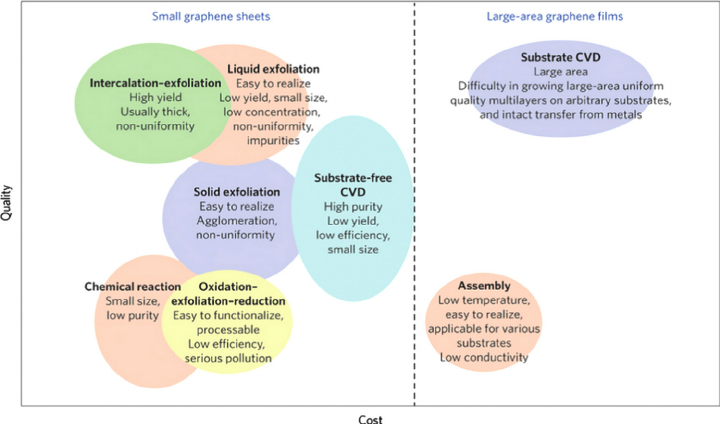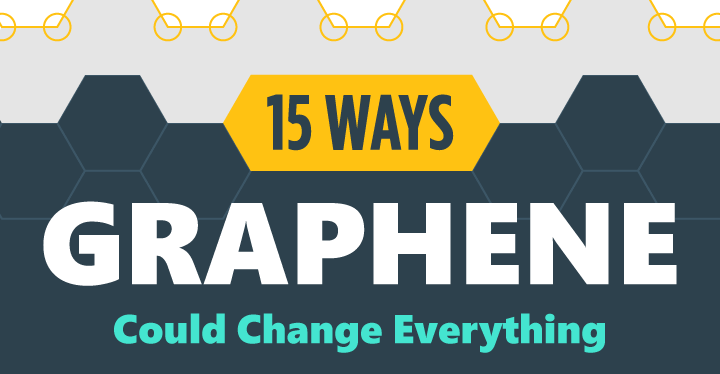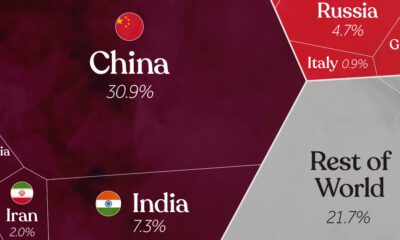Technology
Graphene: The Game-Changing Material of the Future
Technology is only as good as the materials it is made from.
Much of the modern information era would not be possible without silicon and Moore’s Law, and electric cars would be much less viable without recent advances in the material science behind lithium-ion batteries.
That’s why graphene, a two-dimensional supermaterial made from carbon, is so exciting. It’s harder than diamonds, 300x stronger than steel, flexible, transparent, and a better conductor than copper (by about 1,000x).
If it lives up to its potential, graphene could revolutionize everything from computers to energy storage.
Graphene: Is It the Next Wonder Material?
The following infographic comes to us from 911Metallurgist, and it breaks down the incredible properties and potential applications of graphene.

While the properties and applications of graphene are extremely enticing, there has one big traditional challenge with graphene: the cost of getting it.
The Ever-Changing Graphene Price
As you can imagine, synthesizing a material that is one atom thick is a process that has some major limitations. Since a sheet of graphene 1 mm thick (1/32 of an inch) requires three million layers of atoms, graphene has been quite cost-prohibitive to produce in large amounts.
Back in 2013, Nature reported that one micrometer-sized flake of graphene costed more than $1,000, which made graphene one of the most expensive materials on Earth. However, there has been quite some progress in this field since then, as scientists search for the “Holy Grail” in scaling graphene production processes.
By the end of 2015, Deloitte estimated that the market price per gram was close to $100. And today, graphene can now be ordered straight from a supplier like Graphenea, where multiple products are offered online ranging from graphene oxide (water dispersion) to monolayer graphene on silicon wafers.
One producer, NanoXplore, even estimates that graphene is now down to a cost of $0.10 per gram for good quality graphene, though this excludes graphene created through a CVD process (recognized as the highest level of quality available for bulk graphene).
The following graphic from Nature (2014) shows some methods for graphene production – though it should be noted that this is a quickly-changing discipline.

As the price of graphene trends down at an impressive rate, its applications will continue to grow. However, for graphene to be a true game-changer, it will have to be integrated into the supply chains of manufacturers, which will still take multiple years to accomplish.
Once graphene has “real world” applications, we’ll be able to see what can be made possible on a grander scale.
Technology
Visualizing AI Patents by Country
See which countries have been granted the most AI patents each year, from 2012 to 2022.

Visualizing AI Patents by Country
This was originally posted on our Voronoi app. Download the app for free on iOS or Android and discover incredible data-driven charts from a variety of trusted sources.
This infographic shows the number of AI-related patents granted each year from 2010 to 2022 (latest data available). These figures come from the Center for Security and Emerging Technology (CSET), accessed via Stanford University’s 2024 AI Index Report.
From this data, we can see that China first overtook the U.S. in 2013. Since then, the country has seen enormous growth in the number of AI patents granted each year.
| Year | China | EU and UK | U.S. | RoW | Global Total |
|---|---|---|---|---|---|
| 2010 | 307 | 137 | 984 | 571 | 1,999 |
| 2011 | 516 | 129 | 980 | 581 | 2,206 |
| 2012 | 926 | 112 | 950 | 660 | 2,648 |
| 2013 | 1,035 | 91 | 970 | 627 | 2,723 |
| 2014 | 1,278 | 97 | 1,078 | 667 | 3,120 |
| 2015 | 1,721 | 110 | 1,135 | 539 | 3,505 |
| 2016 | 1,621 | 128 | 1,298 | 714 | 3,761 |
| 2017 | 2,428 | 144 | 1,489 | 1,075 | 5,136 |
| 2018 | 4,741 | 155 | 1,674 | 1,574 | 8,144 |
| 2019 | 9,530 | 322 | 3,211 | 2,720 | 15,783 |
| 2020 | 13,071 | 406 | 5,441 | 4,455 | 23,373 |
| 2021 | 21,907 | 623 | 8,219 | 7,519 | 38,268 |
| 2022 | 35,315 | 1,173 | 12,077 | 13,699 | 62,264 |
In 2022, China was granted more patents than every other country combined.
While this suggests that the country is very active in researching the field of artificial intelligence, it doesn’t necessarily mean that China is the farthest in terms of capability.
Key Facts About AI Patents
According to CSET, AI patents relate to mathematical relationships and algorithms, which are considered abstract ideas under patent law. They can also have different meaning, depending on where they are filed.
In the U.S., AI patenting is concentrated amongst large companies including IBM, Microsoft, and Google. On the other hand, AI patenting in China is more distributed across government organizations, universities, and tech firms (e.g. Tencent).
In terms of focus area, China’s patents are typically related to computer vision, a field of AI that enables computers and systems to interpret visual data and inputs. Meanwhile America’s efforts are more evenly distributed across research fields.
Learn More About AI From Visual Capitalist
If you want to see more data visualizations on artificial intelligence, check out this graphic that shows which job departments will be impacted by AI the most.
-

 Markets1 week ago
Markets1 week agoU.S. Debt Interest Payments Reach $1 Trillion
-

 Business2 weeks ago
Business2 weeks agoCharted: Big Four Market Share by S&P 500 Audits
-

 Real Estate2 weeks ago
Real Estate2 weeks agoRanked: The Most Valuable Housing Markets in America
-

 Money2 weeks ago
Money2 weeks agoWhich States Have the Highest Minimum Wage in America?
-

 AI2 weeks ago
AI2 weeks agoRanked: Semiconductor Companies by Industry Revenue Share
-

 Markets2 weeks ago
Markets2 weeks agoRanked: The World’s Top Flight Routes, by Revenue
-

 Demographics2 weeks ago
Demographics2 weeks agoPopulation Projections: The World’s 6 Largest Countries in 2075
-

 Markets2 weeks ago
Markets2 weeks agoThe Top 10 States by Real GDP Growth in 2023















